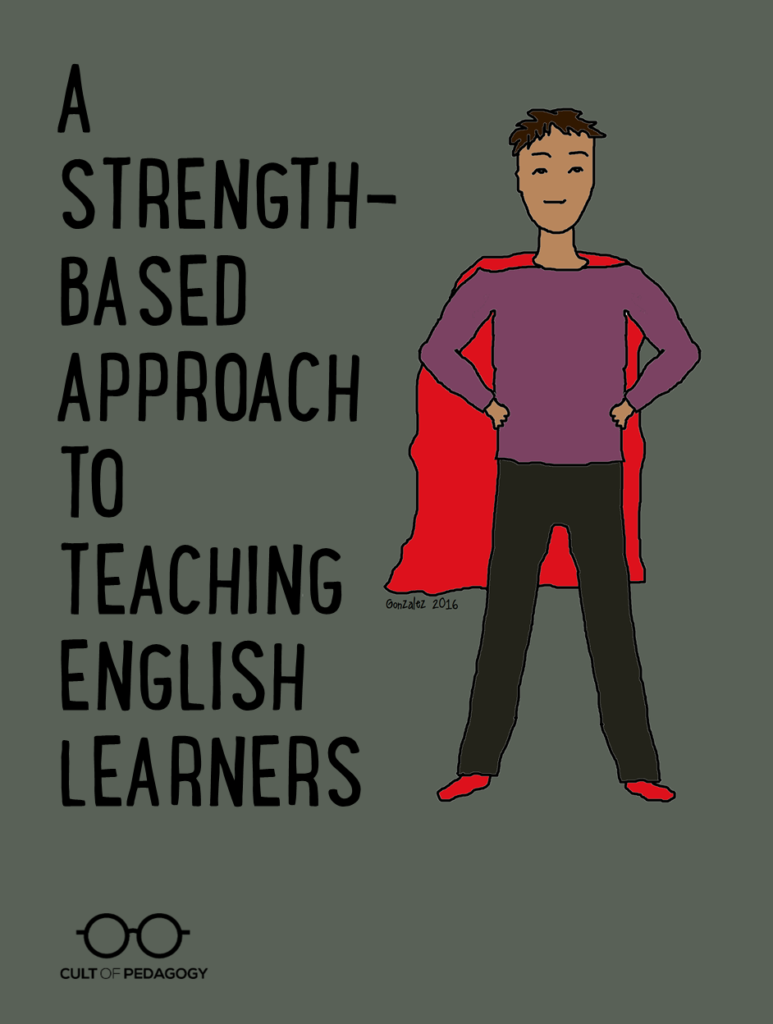
This guest post was contributed by Laura Lenz. It first appeared on her blog,
Teaching with an Open Heart.
Close your eyes.
Imagine a school where we focused on the strengths of English language learners. What if these students’ cultures, languages, countries of origin, unique skills, and life experiences were held up as assets?
Let’s decide this school year to focus more on these strengths and assets and the unique potential of our English learners. What brilliance might be unleashed? What confidence might be built? What might non-ESL* students learn from the ESLs?
This would be a change in the way we view our English learners as well as a shift in how we view the very nature of teaching. The basis of teaching is to teach students what they don’t know. We’re trained to look for gaps in knowledge. We’re the teachers, the experts, the givers of information.
At the beginning of the school year, most teachers will be asked to look at data from state tests. Tests that focus on who is proficient and who is not proficient. We will identify gaps and deficiencies. Of course, this analysis has its place, and we need to know where students are struggling. However, we can also stimulate growth by capitalizing on existing strengths.
A few years ago, I was on an interview committee for the ESL coordinator in our district. The individual who eventually got the job kept talking about the very principles I have outlined in this article. He believed that the English learners could be the stars of the school district. I had never heard anyone express this sentiment quite that passionately and forcefully, and I immediately knew that what he was saying held enormous value. I believe in his vision, and it’s my vision too.
Here are some suggestions for making this shift in how we work with our English learners this year.
1. Make it clear that your students’ first languages and cultures are a tremendous strength and asset.
These students are the newest bilingual or multilingual members of our community. They are also learning to be bicultural or multicultural, figuring out how to navigate the tricky ins and outs of living in a diverse society. Our country will continue to become more diverse, and knowing more than one language and being able to navigate multiple cultures will be highly prized skills in our community. Make sure you explicitly share this information with parents as well. They need to know that their culture and language needs to be preserved and it will only strengthen their child’s future.
2. Uncover students’ unique strengths and funds of knowledge.
Some strengths will be easy to see, like how expert a student is at playing soccer or the great artistic talent some students possess. Some might be a little more difficult to uncover. Make it your job to find the hidden gems that each student has. Sometimes you discover these assets through conversation and questioning, and sometimes you might stumble upon them. By observing carefully, here are a few things I found in my students:
- Our art teacher decided to do a sewing project one week. I walked into the room and the African boys were already amazingly adept with that needle and thread. There they were, heads bent over in concentration, sewing like nobody’s business. It was amazing.
- On one of our field trips we took the class ice skating; most had never done this before. The handful who already knew how to skate took off and skated together, except our Japanese student, who already knew how to skate. I noticed that one by one and with great patience, kindness, and encouragement, she was teaching all the other girls how to ice skate. They trusted her and took risks they may not have taken with their teachers. This kind of interaction among students is something teachers love seeing. This student told us later in the year that she wants to be a teacher.
3. Once you’ve discovered some of their brilliance, make sure you tell them what you see.
Be specific in your praise. Acknowledge students’ strengths in front of the whole class and have conversations with kids privately.
We had to rely on one student sometimes for interpreting when students had conflicts and a bilingual specialist wasn’t available. He was a refugee from Africa, already fairly proficient in oral English and also spoke the two most dominant languages in the classroom. The unexpected joy was realizing that he was also a natural peacemaker with a very keen sensibility for justice and fairness, also possessing a charming sense of humor and sweetness that would make kids laugh and get over things quickly.
My teaching partner and I made sure to tell him that he had something special—the three languages, of course, but even more than that, his natural diplomacy skills. I told him he was going to do something great in his life—be a diplomat or a community organizer. He’d always say, “Thank you, Miss,” while looking slightly embarrassed, yet with a huge smile spread from ear to ear.
Then he told us one day that he wants to be a police officer. I can just imagine the impact he could make, a black police officer who speaks three languages, understands many cultures, and is a natural peacemaker. We should do everything we can to build on this young man’s strengths and help him reach his full potential.
4. Teach your students to validate each other.
One year we did an activity every Friday called “Fill the Bucket,” which comes from a popular children’s book, Have You Filled a Bucket Today? A Guide to Daily Happiness for Kids by Carol McCloud. We drew a different name each week and focused on that person, or if a student was moving, going back to their country, or exiting our program, we would choose them for the activity. The student would sit in the teacher chair at the front of the class and receive praise and compliments from their classmates. We encouraged the kids to be as specific with their praise as possible.
One Friday, it was a particular student’s turn. He was from Saudi Arabia, and we were exiting him from the program because he was proficient enough to transition to mainstream classes in the school. When he sat in front of the class, every hand shot up.
“You’re a great friend.”
“You helped me with my locker on the first day.”
“You’re always so nice to everyone.”
“You make me laugh when I’m worried about things.”
I watched this sweet boy absolutely dissolve into tears. Nobody laughed at his crying. It was incredibly moving and I wondered if he had ever been told how amazing he was. We all need validation.
5. Highlight and elevate the English learners in big and small ways in your classroom, in your school, in your community.
Work on integrating the English learners into the greater school community. Have native English speakers help with the language and academics, but then make sure the English learners have a chance to share their talents and knowledge as well.
We teach all of our kids to play chess and they get really good at it. There are always a few who become especially skilled and competitive. They go to tournaments and compete, including the state tournament. We reached out to the local newspaper and made sure this great story was told to the community.
6. Never forget that refugees and immigrants are doing a tremendously difficult thing simply by trying to make their way in this country.
It takes courage and strength to move to a new country and adapt to a new culture, language, and way of life. Most refugees have already endured unimaginable hardships and are forging ahead despite experiencing loss, grief, danger, and trauma. There is a resilience in refugees and immigrants that is just unbelievable and which they will ultimately use to contribute to their new home and community.
When you point out kids’ strengths to them and to others, they grow in confidence. They know you see them. You see the whole individual, not just an empty vessel that needs to be filled with your knowledge. Not just a kid who doesn’t know English. But a human who already has many unique strengths and assets. Your belief in their value and potential will help their confidence grow. This confidence will enable them to build upon the skills they already have and to be brave enough to learn all the essential things they need to know in this country in order to succeed.
Now, open your eyes.
Decide your model of teaching and working with English learners this year will be a strengths-based one.
You have nothing to lose and everything to gain by trying.
The brilliance and possibilities you uncover might just amaze you. ♦
*Editor’s note: The term ESL is used in several places in this post because it would make the post easier to find when people searched for it. In the English language teaching community, it is more appropriate to describe these learners as English language learners (ELL) or simply English learners, and the process of teaching them as TESOL (Teaching English as a Second or Other Language). These terms more accurately reflect the fact that many of these students come to us already knowing several languages, and the use of “second” does not recognize this asset.
Join the Cult of Pedagogy mailing list and get weekly tips, tools, and inspiration that will make your teaching more effective and fun. You’ll get access to my Members-Only Library of free resources, including my e-booklet, 20 Ways to Cut Your Grading Time in Half.






In the specialized middle school where I teach music, we have exactly 4 NON-ELL scholars. Our English first-language students are the minority. Ms Lenz’ advice is spot on. Thanks for this great new (for me) boots-on-the-ground resource.
Thank you, Sheldon! Your school sounds amazing!
Hey, Sheldon.
That’s INCREDIBLE that you have that many ELs. What a rich cultural experience for your non-EL scholars AND the staff! Laura is right! Your school sounds amazing.
It seems that your colleagues believe in the first principle of effective language instruction: Every EL can learn. I found this belief and six more principles are present in classrooms where the ELs are valued and where language instruction is carefully designed. Do you think the remaining principles are present at your school? I’m sure they are!
http://www.empoweringells.com/principles/
Thank you for writing such a wonderful article. It can be useful for all who teach.
Thanks, Jennifer! 🙂
Your support means a lot to me.
Thanks for this! As both a teacher and a parent of students on IEPs, I think about this ALL the time. Especially as a parent (and doubly, my children were ESL students as well).
I especially see issues with the phrasing and tone of IEPs — so often very specific about what’s missing, but with the statement of student strengths vague and often not really tied well to academics. One effect is that when we read the IEPs of students new to us this draws us to their difficulties, and the strengths become surprises instead of expectations.
Great points, Tom. So many things are set up to focus on weaknesses. We have to really work to focus on strengths. Thanks for reading.
Thank you, Sheldon, for sharing this amazing insight.
Thanks for reading!
Love this. I use high-interest content based instruction (except with beginners who need social language, then I use CI/TPRS) to build lessons around whatever content area feels empowering to kids. I love that this article takes that a step further to look at how to honor kids’ abilities around the school in other ways. Brilliant message! https://compassionateesl.com/2016/08/03/high-interest-content-based-instruction/
I love your article and your site, Claire. We are on the same page. 🙂
I’m in love with your site too! Thanks!
H
Great article. Is “fonts” of knowledge a “typo?”. If not, pleas clarify?
Hey G. Thanks for the heads up. I think there is an expression “font of knowledge,” but since we published this, I have been introduced to the Funds of Knowledge theory (Moll et al), which is ultimately what Lisa is referring to here, so we are going to go ahead and change it. Thanks!
Thank you! It is so easy to be caught up in what our students need to know that we forget to validate how much they DO know and contribute to our school climate. I really appreciate the idea of “Fill the Bucket.” I haven’t heard that particular term before, but I will do my best to spread it around my school site. Our district is a Title 1 district with a high population of migrant students, so this article really struck a chord with me.
Thanks for reading, M! That Fill the Bucket activity has been SO powerful. The kids love it and it really promotes kindness.
have you seen the book.. how.full is your bucket… by tom rath.
.it’s a great book even for a fun professional development course.
I don’t know that one, but I”ll check it out. Are you talking about a children’s book?
Hi Laura, Thanks for putting the word out there! We can’t express this message enough–starting with strengths and honoring students’ (and families’) stories is KEY. If you’d like to see an entire publication devoted to this topic, see the Annenberg Institute’ Voices in Urban Education, “ELLs: Shifting to an Asset-Based Paradigm”–http://vue.annenberginstitute.org/issues/37. Full of awesome examples in programming from across the country. Also, I happily share our free tool to check our belief systems and practices called “Mindset Check” https://ellstudents.com/collections/protocols/products/mindset-check
Backing up to check ourselves first can make ALL the difference for ELL students (and ALL students)!
–Sarah Ottow, Director & Lead Coach, Confianza: Educating for ELL Equity
Sarah! Thank you SO much for all of these links. Great stuff!
Laura! Thank you for this article! I am a student at the University of Illinois at Urbana-Champaign studying mathematics with a minor in secondary education, and something that we have reinforced throughout the past year is the notion of equitable education for all students. Something that speaks power to me is the empowerment of ESL students and highlighting their strengths. There are many lessons that can be learned from these students, and we should praise our students for their character and respect for their peers. I want to have this attitude in my classroom whether I have ESL students or not.
Andrew- Your comments give me a lot of hope for the future of education. It makes me so happy that people with your mindset and heart are going to be our future teachers. Thanks for reading and commenting. It means a lot to me. And, all of this definitely applies to all students.
As an ELL middle school teacher, this was such a wonderful article to see pop up on my news feed. This year we’ve been doing a lot of personal writing with my intermediate students, as well as using Dialogue Journals for the first time (which I learned about from an earlier Cult of Pedagogy blog post). My students are so proud to show off what they know while also helping them develop their language skills.
Hi, Stephanie! Writing is so huge. I love dialogue journals. So helpful with both writing and with processing personal issues. At the end of the year, we have our students write their stories and we publish them in a class book. It is really powerful and always one of the best things we do every year.
Hello, I am student in the secondary mathematics education program at the university of Illinois. Thank you for your insights in this article. I really appreciate that the strategies you mention focus on students’ strengths and not a deficit model. I think it’s important to realize that these English language learners already know another language so they are in some ways ahead of the game although this may cause difficulties for them in the classroom. So it is important that we as teachers provide the necessary supports to help these students be successful and demonstrate their talents because they can be “the stars of the school district.” Furthermore you mention how these students have experiences that our other students and even we as teachers don’t have. It is important that we recognize and learn from these when possible. For example, one of my professors told us about a strategy that some students from a different culture used to check their work on a long division problem. It was a completely different method than she had seen before, but was quicker than other methods and did work. It is important to value student ideas like this and actually explore them. Furthermore I appreciate many of your ideas like the “fill the bucket” activity. This can benefit not only emerging bilingual/multilingual students, but the whole class. Thanks!
Hey, John. I’m SO encouraged that people like you are becoming teachers. Keep going! You’re right that they have a lot of strengths already and knowing another language is an incredible asset. I really appreciate you taking the time to share your thoughts. Good luck in your studies!
This strength based approach is everything I am trying this school year, so thank you for this article. In the past, I’ve relied on technology and translation services to make the esl students in my mainstream classes understand what I’m saying, but what I really need to do is to work to understand what the students have to say both literally and figuratively. (I even am sitting in on a Spanish class during my prep period to help me in the literal sense). With your thoughts, I’ve even seen success with a Korean student joining the Korean club (two girls taught them self the language because they loved k-pop) and now he finally feels like he fits in and is truly a star. Thank you!
I love your comment, Alyssa. And, I’m so happy about your approach. Your hard work will pay off. Best of luck.
Hi Laura
Thanks for a great article. I hope you don’t mind me mentioning a tool that might fit really well with your approach.
We use strengths cards (www.atmybest.com) to help encourage strengths-focused conversations, both in terms of self-reflection and sharing what strengths you notice in others. Having a simple frame of reference makes it easier for students (and staff) to identify exactly what qualities that they appreciate in themselves and others.
We recently created a free online tool that’s based on the cards – you might want to check it out. I’d love to hear what you think! http://www.atmybest.com/online-tools
Hey Martin! I just did the self-reflection and it was really cool. Thanks for sharing it!
Thanks, glad you like it! 🙂
If you want to chat about featuring any of our tools on your site, feel free to drop me a line at mgalpin@workpositive.com.
Enlightening read. I am happy to see Novato High School has forward thinking teachers like you. The community of Novato has changed and the school system needs to change with it. Students from other cultures and languages add to the teaching and learning experience. Thank you.
I loved reading this piece! I’m in school now to become an Elementary teacher. I find the things you suggested to be very helpful, and I’m excited to try them in my classroom one day!
Kudos to Novato High School for providing ESL students a voice, and for allowing their individual strengths to shine. So often students from other countries feel like they don’t matter. Little thought goes into the funds of knowledge they bring to the classroom – especially in the mainstream. You celebrate their knowledge and their individuality. Excellent!
Anne Swigard
Educational
I pressed the Post Comment button a little too soon!
Cheers!
Anne Swigard
Educational Training Specialists, LLC
https://training4teachers.com
I will be sharing this with new teachers at my school, such a clearly outlined practical approach to additive perspective. I also think that this advice will resonate with teachers who work with ELLs as well as those who (purportedly) do not. I think it’s wonderful that you reference Luis Moll and Norma González’s seminal work on funds of knowledge, which transformed the way we think about both teaching language learners and engaging families. I wonder if it might be a good idea to cite him (and his team) appropriately so they can receive due credit and so that teachers reading this know where to go for more into? ¡Gracias! Talía
Thank you for sharing such an important post. I have conversations about changing mindset with my teachers around our English learners constantly. I encourage them to examine their language in professional conversations. Instead of “they are low” to “ they are emerging English learners.”
One of the early books in the general area of emotional support in the ESL/EFL classroom was Caring and Sharing in the Foreign Language Classroom by Gertrude Moskowitz. It may still be available in libraries. There are many good exercises similar to the Fill Your Bucket exercise.
Hi Laura, I’m the Managing Editor of the EL Gazette, a UK-based English language teaching industry magazine, with a global reach. We would love to get your point of view on this topic out to our readers. Would you be interested in adapting it slightly to fit our format? Let me know and I can send you more details. This would be for our March 2020 issue, to be published around the 25th of Feb, with a deadline of 13 Feb for the copy. Cheers. Ron
Hey Ron,
Because this post is a couple years old, Laura might not see this. We suggest contacting her via her home page, Teaching with an Open Heart. Hope this helps.
This is a great approach! Respect for different cultures and learning with individual attention!
I fully agree with the importance of knowing several languages. Thank you for the interesting article! I think I should try to learn more about some of my students’ native culture.
Good Reading! Enjoyed!
It is important to remember everyone has some strength, even when we can not see them do to…whatever factors might be in the way. In the rush to execute curriculum, I can sometimes overlook the experience of my ELL students. After reading all of this I am going to work to keep their strength at the center of my planning.